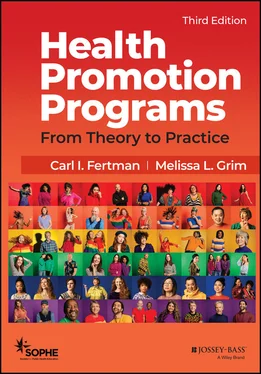(SOPHE) Society for Public Health Education - Health Promotion Programs
Здесь есть возможность читать онлайн «(SOPHE) Society for Public Health Education - Health Promotion Programs» — ознакомительный отрывок электронной книги совершенно бесплатно, а после прочтения отрывка купить полную версию. В некоторых случаях можно слушать аудио, скачать через торрент в формате fb2 и присутствует краткое содержание. Жанр: unrecognised, на английском языке. Описание произведения, (предисловие) а так же отзывы посетителей доступны на портале библиотеки ЛибКат.
- Название:Health Promotion Programs
- Автор:
- Жанр:
- Год:неизвестен
- ISBN:нет данных
- Рейтинг книги:5 / 5. Голосов: 1
-
Избранное:Добавить в избранное
- Отзывы:
-
Ваша оценка:
- 100
- 1
- 2
- 3
- 4
- 5
Health Promotion Programs: краткое содержание, описание и аннотация
Предлагаем к чтению аннотацию, описание, краткое содержание или предисловие (зависит от того, что написал сам автор книги «Health Promotion Programs»). Если вы не нашли необходимую информацию о книге — напишите в комментариях, мы постараемся отыскать её.
Health Promotion Programs: From Theory to Practice
Health Promotion Programs: From Theory to Practice
Health Promotion Programs — читать онлайн ознакомительный отрывок
Ниже представлен текст книги, разбитый по страницам. Система сохранения места последней прочитанной страницы, позволяет с удобством читать онлайн бесплатно книгу «Health Promotion Programs», без необходимости каждый раз заново искать на чём Вы остановились. Поставьте закладку, и сможете в любой момент перейти на страницу, на которой закончили чтение.
Интервал:
Закладка:
An ecological perspective on health emphasizes the interaction between and interdependence of factors within and across levels of a health problem. The ecological perspective highlights people’s interaction with their physical and sociocultural environments. McLeroy et al. (1988) identified three levels of influence for health-related behaviors and conditions: (1) the intrapersonal level (or individual level), (2) the interpersonal level, and (3) the population level. The population level encompasses three types of factors: institutional or organizational factors, social capital factors, and public policy factors ( Table 1.1).
Table 1.1 Ecological Health Perspective: Levels of Influence
| Concept | Definition |
|---|---|
| Intrapersonal level | Individual characteristics that influence behavior, such as knowledge, attitudes, beliefs, and personality traits |
| Interpersonal level | Interpersonal processes and primary groups, including family, friends, and peers, that provide social identity, support, and role definition |
| Population levelInstitutional factors Social capital factors Public policy factors | Rules, regulations, policies, and informal structures that may constrain or promote recommended behaviors Social networks and norms or standards that may be formal or informal among individuals, groups, or organizations Local, state, and federal policies and laws that regulate or support healthy actions and practices for prevention, early detection, control, and management of disease |
| Source : Adapted from McLeroy, K. R., Bibeau, D., Steckler, A., & Glanz, K. (1988). An ecological perspective on health promotion programs . Health Education Quarterly, 15, 351–377. |
Health promotion programs provide planned, organized, and structured activities and events over time that focus on helping individuals make informed decisions about their health. Health promotion programs promote policy, environmental, regulatory, organizational, and legislative changes at various levels of government and organizations. These two complementary types of interventions by design achieve specific objectives to improve the health of individuals as well as, potentially, all individuals at a site. Health promotion programs take advantage of the pivotal position of their setting within schools, colleges and universities, workplaces, healthcare organizations, and communities to reach children, adults, and families by combining interventions in an integrated, systemic manner.
Health promotion programs are designed to work with a priority population(in the past called a target population )—a defined group of individuals who share some common characteristics related to the health concern being addressed. Programs are planned, implemented, and evaluated to influence the health of a priority population. The foundation of any successful program lies in gathering information about a priority population’s health concerns, needs, knowledge, attitudes, skills, and desires related to the disease focus. At the planning stage, it is also important to engage schools, workplaces, healthcare organizations, and communities where the priority population lives and interacts to seek their cooperation and collaboration,
Finally, health promotion programs are concerned with prevention of the root causes of poor health and lack of well-being resulting from discrimination, racism, or environmental assaults—in other words, the social determinants of health. Addressing root causes of health problems is often linked to the concept of social justice. Social justice and health equity are the belief that every individual and group is entitled to fair and equal rights and equal participation in social, educational, and economic opportunities. Health promotion programs have a role in increasing understanding of oppression and inequality and taking action to improve the quality of life for everyone.
Historical Context for Health Promotion
Kickbush and Payne (2003) identified three major revolutionary stages in the quest to promote healthy individuals and healthy communities. The first stage, which focused on addressing sanitary conditions and infectious diseases, occurred in the mid-19th century. The second stage was a shift in community health practices that occurred in 1974 with the release of the Lalonde report, which identified evidence that an unhealthy lifestyle contributed more to premature illness and death than lack of healthcare access (Lalonde, 1974). This report set the stage for health promotion efforts. In the third stage promoting health for everyone challenged us to identify the various combinations of forces that influence the health of a population and community now within the context and consequences of COVID-19.
Stage 1: Sanitation, Infectious Disease, and Spanish Flu Pandemic
In the mid-19th century, John Snow, a physician in London, traced the source of cholera in a community to the source of water for that community. By removing the pump handle on the community’s water supply, he prevented the agent (cholera bacteria) from invading community members (hosts). This discovery not only led to the development of the modern science of epidemiology but also helped governments recognize the need to combat infectious diseases. Initially, governmental efforts focused only on preventing the spread of infectious diseases across borders by implementing quarantine regulations (Fidler, 2003), but ultimately, additional ordinances and regulations governing sanitation and urban infrastructure were instituted at the community level. The Spanish flu pandemic of 1918 infected an estimated 500 million people worldwide—about one-third of the planet’s population—and killed an estimated 20 million to 50 million victims, including some 675,000 Americans. The 1918 flu was first observed in Europe, the United States, and parts of Asia before swiftly spreading around the world. At the time, there were no effective drugs or vaccines to treat this killer flu strain. Government officials to prevent the virus spread and promote and protect peoples’ health imposed quarantines, ordered citizens to wear masks and shut down public places, including schools, churches, and theaters. People were advised to avoid shaking hands and to stay indoors, libraries put a halt on lending books, and regulations were passed banning spitting. By the 1940s in the United States, water and sewer systems were constructed across the nation. The regulatory focus had expanded to include dairy and meat sanitation, control of venereal disease, and promotion of prenatal care and childhood vaccinations (Perdue et al., 2003).
Stage 2: Lifestyle Factors and Chronic Disease
As environmental supports for addressing infectious diseases were initiated (for example, potable water and vaccinations), deaths from infectious diseases were reduced. Compared with people who lived a century ago, most people in our nation and other developed nations are living longer and have a better quality of life—and better health. While new infectious diseases (e.g., HIV/AIDS, bird flu, MRSA, Ebola, COVID-19) have emerged since the end of the 20th century and continue to demand the attention of health workers, the emphasis of health promotion shifted in the last quarter of the 20th century to focus on the prevention and treatment of chronic diseases and injury, which are the leading causes of illness and death. This change was stimulated, in part, by the Lalonde report, which observed in 1974 that health was determined more by lifestyle than by human biology or genetics, environmental toxins, or access to appropriate healthcare. It was estimated that one’s lifestyle—specifically, those health risk behaviors practiced by individuals—could account for up to 50 percent of premature illness and death. Substituting healthy behaviors, such as avoiding tobacco use, choosing a diet that was not high in fat or calories, and engaging in regular physical activity, for high-risk behaviors (tobacco use, poor diet, and a sedentary lifestyle) could prevent the development of most chronic diseases, including heart disease, diabetes, and cancer (Breslow, 1999).
Читать дальшеИнтервал:
Закладка:
Похожие книги на «Health Promotion Programs»
Представляем Вашему вниманию похожие книги на «Health Promotion Programs» списком для выбора. Мы отобрали схожую по названию и смыслу литературу в надежде предоставить читателям больше вариантов отыскать новые, интересные, ещё непрочитанные произведения.
Обсуждение, отзывы о книге «Health Promotion Programs» и просто собственные мнения читателей. Оставьте ваши комментарии, напишите, что Вы думаете о произведении, его смысле или главных героях. Укажите что конкретно понравилось, а что нет, и почему Вы так считаете.












